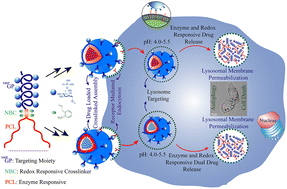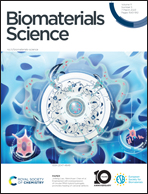Dual stimuli-responsive cross-linked nanoassemblies from an amphiphilic mannose-6-phosphate based tri-block copolymer for lysosomal membrane permeabilization†
Abstract
Stimuli-responsive cross-linked nanocarriers that can induce lysosomal cell death (LCD) via lysosomal membrane permeabilization (LMP) represent a new class of delivery platforms and have attracted the attention of researchers in the biomedical field. The advantages of such cross-linked nanocarriers are as follows (i) they remain intact during blood circulation; and (ii) they reach the target site via specific receptor-mediated endocytosis leading to the enhancement of therapeutic efficacy and reduction of side effects. Herein, we have synthesized a mannose-6-phosphate (M6P) based amphiphilic ABC type tri-block copolymer having two chains of FDA-approved poly(ε-caprolactone) (PCL) as the hydrophobic block, and poly(S-(o-nitrobenzyl)-L-cysteine) (NBC) acts as the photoresponsive crosslinker block. Two different tri-block copolymers, [(PCL35)2-b-NBC20-b-M6PGP20] and [(PCL35)2-b-NBC15-b-M6PGP20], were synthesized which upon successful self-assembly initially formed spherical uncross-linked “micellar-type” aggregates (UCL-M) and vesicles (UCL-V), respectively. The uncross-linked nanocarriers upon UV treatment for thirty minutes were covalently crosslinked in the middle PNBC block giving rise to the di-sulfide bonds and forming interface cross-linked “micellar-type” aggregates (ICL-M) and vesicles (ICL-V). DLS, TEM, and AFM techniques were used to successfully characterize the morphology of these nanocarriers. The dual stimuli (redox and enzyme) responsiveness of the cross-linked nanocarriers and their trafficking to the lysosome in mammalian cells via receptor-mediated endocytosis was probed using confocal microscopy images. Furthermore, the addition of a chloroquine (CQ, a known lysosomotropic agent) encapsulated cross-linked nanocarrier (CQ@ICL-V) to non-cancerous (HEK-293T) cells and liver (HepG2), and breast cancer cells (MDA-MB-231) was found to initiate lysosomal membrane permeabilization (LMP) followed by lysosomal destabilization which eventually led to lysosomal cell death (LCD). Due to the targeted delivery of CQ to the lysosomes of cancerous cells, almost a 90% smaller amount of CQ was able to achieve similar cell death to CQ alone.

- This article is part of the themed collection: #RSCPoster Twitter Conference


 Please wait while we load your content...
Please wait while we load your content...